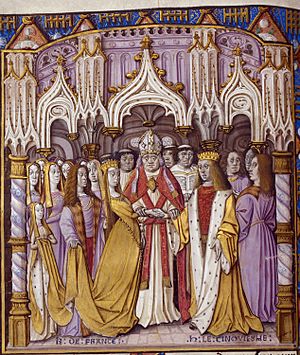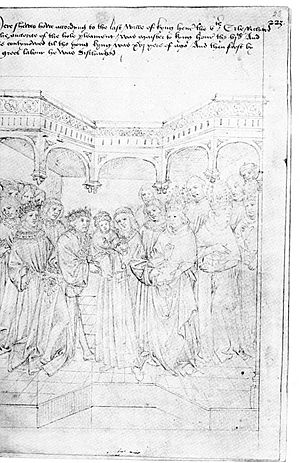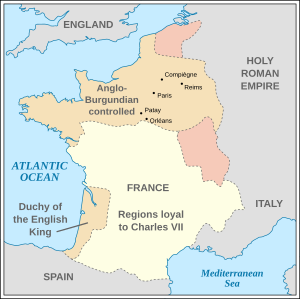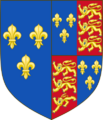Dual monarchy of England and France facts for kids
Quick facts for kids
Dual monarchy of England and France
|
|||||||||||||
|---|---|---|---|---|---|---|---|---|---|---|---|---|---|
| 1422–1453 | |||||||||||||
|
The Royal Arms of England during Henry VI's reign
|
|||||||||||||
| Status | Personal union between the Kingdom of England and the Kingdom of France | ||||||||||||
| Capital | None | ||||||||||||
| Government | Monarchy | ||||||||||||
|
• 21 October 1422 – 19 October 1453
|
Henry VI of England and II of France | ||||||||||||
| Historical era | Middle Ages | ||||||||||||
| 21 May 1420 | |||||||||||||
|
• Death of Charles VI of France
|
21 October 1422 | ||||||||||||
|
• Coronation of Henry II at Notre-Dame de Paris
|
16 December 1431 | ||||||||||||
| 20/21 September 1435 | |||||||||||||
|
• Loss of Bordeaux
|
19 October 1453 | ||||||||||||
|
|||||||||||||
The dual monarchy of England and France was a time when the kings of England also claimed to be kings of France. This happened during the later part of the Hundred Years' War. It began on October 21, 1422, when King Charles VI of France died.
Before his death, Charles VI had signed the Treaty of Troyes. This agreement said that his son-in-law, Henry V of England, and Henry's future children would inherit the French crown. This meant Charles VI's own son, the Dauphin Charles, was left out. The Dauphin was the rightful heir by French law.
Henry V's son, Henry VI of England, became king of both England and France. However, only the English and their allies, the Burgundians, recognized him as King Henry II of France. He was crowned King of France in Paris on December 16, 1431.
In reality, Henry VI's power as King of France was only recognized in the parts of France controlled by the English and their allies. These areas were managed by his French regency council (a group of people ruling for a young king). Meanwhile, the Dauphin ruled as King Charles VII in the southern parts of France.
Charles VII was crowned King of France at Reims on July 17, 1429. This was largely thanks to Joan of Arc, who believed it was her mission to free France from English rule. In 1435, Philip the Good, the Duke of Burgundy, changed sides. He recognized Charles VII as the true King of France. This was a big blow to Henry VI's power in France.
The dual monarchy ended when Charles VII's forces captured Bordeaux on October 19, 1453. This happened after their victory at the Battle of Castillon. This battle also marked the end of the Hundred Years' War. The English were forced out of almost all the lands they controlled in France, except for Calais. Charles VII then became the undisputed king of nearly all of France.
Contents
The Hundred Years' War: A Long Conflict
England and France had been fighting for a long time over who should rule parts of France. This conflict was called the Hundred Years' War (1337–1453). It was a series of battles and temporary truces.
In the first part of the war, Edward III of England won big victories at Crécy and Sluys. His son, Edward, the Black Prince, even captured the French king John II of France at the Battle of Poitiers in 1356.
In 1360, the Treaty of Brétigny was signed. The French king was set free for a huge ransom. England gained more land in Aquitaine. However, Edward III had to give up his claim to the French throne. This claim came from his mother, Isabella of France.
Later, Charles V of France became king. In 1369, France started the war again. This time, the English suffered defeats. Charles V avoided big battles and focused on capturing English castles. The English lost most of their lands in Aquitaine. By 1377, Edward III died, and his grandson Richard II of England became king.
Another truce happened in 1396 when Richard II married Isabella of Valois, daughter of King Charles VI of France. But peace didn't last. In 1399, Henry IV of England took Richard's throne. This led to more fighting in 1403, starting the third phase of the war.
The House of Lancaster and French Troubles
Henry IV became king of England. His reign was full of internal problems, like rebellions in Wales and the north.
Meanwhile, France was in a civil war. Two powerful groups, the Armagnacs and the Burgundians, were fighting. Louis, Duke of Orléans, who was Charles VI's brother, was killed by order of John the Fearless, the Duke of Burgundy. This made the French civil war even worse.
Henry IV was seen as an important ally in this French conflict. The Armagnacs even offered to give back the Duchy of Aquitaine for military help. Henry sent troops to support them in 1412.
The civil war in France continued. John the Fearless claimed to be the regent (a person who rules for a king who is too young or sick) for the young dauphin Charles and the unwell King Charles VI of France. Henry IV died in 1413, and his son, Henry V of England, became king.
Henry V: The Warrior King
Henry V was a skilled warrior from a young age. He fought in the Welsh wars and was wounded at the Battle of Shrewsbury in 1403. Despite an arrow piercing his face, he refused to leave the battle, and the English won.
When Henry V became king, France was still in civil war. Henry demanded that the French king give him back many lands, including an extended Aquitaine, Normandy, and other provinces. The French refused. In 1415, Henry, at 28, invaded France.
The 1415 Campaign
On August 11, 1415, Henry sailed to France. His forces captured the fortress at Harfleur on September 22. Then, Henry marched his army towards Calais.
On October 25, 1415, near the village of Agincourt, Henry's tired and outnumbered army faced a large French army. Henry led his men to a huge victory, decisively defeating the French. Thousands of French soldiers died. This victory was just the first step for the English.
The 1417 Campaign
After two years of planning, Henry renewed the war in 1417 on a larger scale. He quickly conquered Lower Normandy and besieged Rouen. The French were weakened by their own internal fights between the Burgundians and Armagnacs. Henry used this to his advantage.
In January 1419, Rouen fell. Those who resisted were punished. By August, the English were near Paris. The French civil war took a dramatic turn when John the Fearless was killed by the Dauphin's supporters.

Philip the Good, the new Duke of Burgundy, then allied with Henry. After six months of talks, the Treaty of Troyes was signed. It recognized Henry as the heir and regent of France. On June 2, 1420, Henry married Catherine of Valois, daughter of Charles VI of France. Henry's army then captured more castles. His son, Henry VI, was born the next year.
The 1421 Campaign and Henry V's Death
On June 10, 1421, Henry returned to France for his last military campaign. His forces captured Dreux and then Meaux in May 1422.
Henry V died suddenly on August 31, 1422, near Paris, likely from illness. He was only 35. Before he died, Henry V named his brother, John, Duke of Bedford, as regent of France for his infant son, Henry VI. Henry V never lived to be crowned King of France himself. Charles VI, the French king, died two months after Henry V. So, Henry V's son, Henry VI, became king of both England and France.

Who Would Rule France for the Young King?
After Henry V's death, the question of who would rule France for the baby King Henry VI was important. The Duke of Bedford, the Duke of Burgundy, and the French Estates-General (a kind of parliament) met. They confirmed the Treaty of Troyes. Bedford was made governor of Normandy and Burgundy, and he became the regent for the King of France.
Bedford was very dedicated to his role as French regent for his nephew, King Henry VI. The Treaty of Troyes was confirmed again. On November 19, Bedford officially took his place as French regent in Paris.
Henry VI was now King of France, which included Normandy and Gascony. The Duke of Bedford was happy with his role and stayed in France. Philip of Burgundy needed English support because his father, John the Fearless, had been killed by the Dauphin's men.
Henry V's plan had a problem: he didn't expect to die before Charles VI. The treaty had limited his choices on his deathbed. His plans were for the short term (until Charles VI died) and the long term (when Henry VI would rule both kingdoms). This strong alliance between England and Burgundy was key for the English commanders.
Charles VI's death did not break the alliance between England and Burgundy. It also didn't change the legal dual monarchy of England and France.
English Rule in France
To keep their French lands, the English needed a strong navy for defense. The Treaty of Troyes in 1420 brought political stability and the alliance with Burgundy. In 1423, John VI, Duke of Brittany, also joined this alliance. By 1428, the English, led by Thomas Montacute, 4th Earl of Salisbury, were moving towards the Loire River.
In the 1420s, Gascony was safe from French attacks because it was cut off by sea and land. It was protected by French nobles who supported the English. Calais was also well-protected and had good trade with Northern Europe. Normandy and the Île-de-France region were protected by the French Regent.
The Duke of Brittany stayed allied with the English because he wanted his duchy to remain independent. However, Arthur de Richemont, a Breton noble, later supported Charles VII. As the English moved into French territory, relations with Brittany worsened in 1424.
The alliance with Burgundy was very important for English trade. However, this alliance was tested when Humphrey, Duke of Gloucester (Henry VI's uncle), married Jacqueline of Hainault in 1423. This led to a disastrous English campaign in Hainault in 1424, which strained relations with Burgundy.
Bedford relied on English money to support his armies in France. Money from Normandy, Gascony, and Calais was used for defenses and garrisons.
English Attacks (1422–1429)
The dual monarchy encouraged both Englishmen and northern Frenchmen to fully control France. In the 1420s, England sent troops to France. Many English nobles were given French estates. Most of Normandy was made stable, except for Mont Saint-Michel.
The English strategy spread across the Seine valley and Paris. The western border with Brittany was also strengthened. In 1424, Bedford planned a campaign to conquer the Maine-Anjou and Picardy regions. This led to the Battle of Verneuil. Bedford gained a good reputation after this victory. It was also a big defeat for the Scots, who supported Charles VII.
Bedford's conquests meant that King Henry's French capital was no longer on the front lines. Bedford promised the Normans that they would not suffer from heavy taxes.
After Henry V's death, the Duke of Bedford wanted to bring Brittany and Burgundy closer to the English cause. In 1423, at the Treaty of Amiens, the three dukes (John VI of Brittany, John of Bedford, and Philip the Good) formed an alliance. They recognized Henry VI as King of France and agreed to work together against Charles VII. This treaty also arranged the marriage of Anna of Burgundy (Philip's sister) to John, Duke of Bedford.
However, the alliance of Amiens was almost broken when Brittany and Burgundy secretly agreed to be friends if either made peace with Charles VII. Even though both recognized Henry VI, friendly relations remained between Brittany and Burgundy. Burgundy later broke its agreements with the English at the Treaty of Arras.
By 1424, French estates were being sold widely. English settlers bought properties in coastal cities like Cherbourg, Caen, and Harfleur. However, enthusiasm for conquering all of France began to fade. Relations between England and Burgundy became tense after Gloucester's campaign in Holland in 1424. Brittany also lost interest in the alliance.
In 1428, the Scots continued to support Charles VII. French envoys were sent to Scotland to propose an alliance and a marriage between King James I of Scotland's daughter and Charles' son, Louis.
The English military in Normandy was led by Bedford, Warwick, and Suffolk. In 1427, Brittany was forced to become a Vassal again after fighting the English.
The city of Orléans was very important for the French. The Earl of Salisbury began the siege in 1428. However, Salisbury's death early in the siege hurt English morale. The French were revived by the arrival of Jeanne d'Arc (Joan of Arc). She lifted the siege, and Charles VII was crowned in Rheims, the traditional place for French kings.
This news greatly worried the English. The coronation of Henry VI in Paris became a key way to counter Charles VII's success. The events at the Loire River were a major test for the English-French military plan.
Two Coronations (1429–1431)
Henry VI had two coronations. The first was in England at Westminster Abbey on November 6, 1429. The second was in Paris at Notre-Dame on December 16, 1431.
The English coronation happened because the Siege of Orléans had failed. Henry's English and French advisors suggested it. His English coronation had already been delayed for seven years.
John of Lancaster, 1st Duke of Bedford, suggested the French coronation in Paris. He believed it would cancel out Joan of Arc's victory and Charles VII's coronation in Reims. Charles's coronation in Reims on July 16, 1429, was very important symbolically.
During Henry's English coronation in 1429, poems by John Lydgate were read. They highlighted Henry's claim to both England and France. They linked Henry to his grandfather, Charles VI of France, through his mother, Catherine of Valois. He was also linked to Saint Louis and Edward the Confessor.
The actual crowning was done by Cardinal Beaufort. This was unusual because the bishop of Paris traditionally performed this role. The coronation was carefully planned to show Henry's dual claim. A play was even performed showing a boy representing the King of England and France balancing two crowns.
On April 23, 1430, Henry sailed to France. On December 16, 1431, he traveled to the Basilica of St Denis, a burial place for French kings, before his coronation. The coronation was held at Notre-Dame Cathedral. Henry's procession was grand, with trumpeters and thousands of guards.
The procession went through Paris, where the young king kissed holy relics at the Sainte Chapelle. The English Chapel Royal choir joined the Paris cathedral choir for the ceremony. Cardinal Beaufort performed the crowning, which was another break from tradition.
Despite the grand ceremony, the coronation didn't achieve much. England's allies, especially Burgundy, were becoming less reliable. It was discovered that Philip of Burgundy had made a secret truce with Charles VII just before the coronation.
The coronation was mainly an English event. It didn't stop the French from taking back more territory. Henry, with little to show for his two years in France, returned to England. He never set foot in his French kingdom again.
In 1432, Henry Chichele, Archbishop of Canterbury, said that Henry's visit had not worked. It had shown that English power in Normandy was weakening. Bedford was also mourning the death of his wife, Anne of Burgundy. He then married Jacquetta of Luxembourg, which further strained relations with Philip the Good. The last three years saw England struggle to keep fighting, and Philip found the war too expensive.
Images for kids
See also








